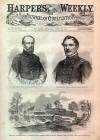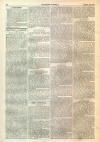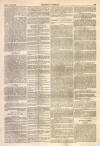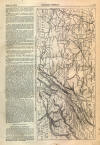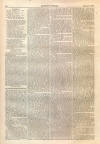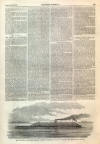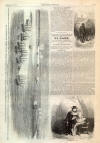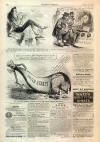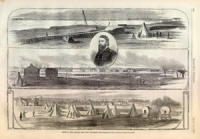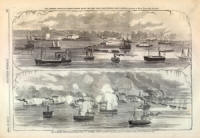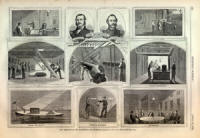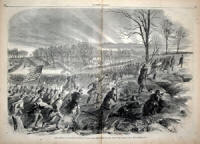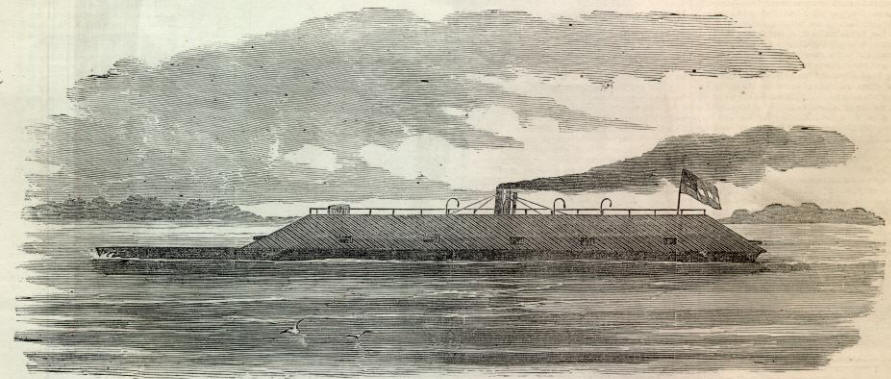Battle of Winchester
|
|
This Site:
|
APRIL 12, 1862.] HARPER'S WEEKLY. 235 swept up the creek dear old Kit stepped out of his cover, his hands and face black with powder, and his forehead bleeding, but only from the splinter of a bad cap. "You're welkim, boy!" he said, as we shook hands; "'twar getting hot, though I peppered one or two of the varmints. They got on my trail right smart when yew quit; but they ain't got me this time, I reckon." Prudence forbade our small party from attempting the mountain-passes that night to learn the fate of our comrades, but early the next day we reached Deer Creek. As we had anticipated, we found the two Germans dead in the creek, where the fatal ambush had been laid for them. Of the artist we could find no traces, but on our return to the ferry we found him there. Though unhurt, his plight was ludicrously doleful. The Indians had discovered him in the cedar, and it would have fared ill with him but that the sketch of the young Indian was found on his person, drawn so accurately that all his captors recognized it. Believing from this circumstance that he was a great "medicine" man whom it would be dangerous to injure, they stripped and released him. THE BATTLE OF WINCHESTER.WE publish on pages 232 and 233 a large picture of the BATTLE OF WINCHESTER from a sketch drawn by our special artist, Mr. A. R. Waud; and on page 225 a portrait of the hero of the day, General Shields. The Herald correspondent furnished that paper with the following graphic account of the battle: On Saturday afternoon, March 15, at about a quarter past two o'clock, our advanced pickets on the Strasburg road discovered the rebel cavalry under the madcap Ashby about half a mile beyond them, reconnoitring the woods on both sides of the turnpike, and steadily advancing. Our pickets consisted of a few men of the Fourteenth Indiana infantry at that point, and they fell back half a mile to the hamlet of Kernstown, four miles from Winchester. The rebels, observing our pickets fall back, were confirmed in the belief that our forces here did not exceed five thousand men. They then gave chase. Coming up with our men, Ashby cried at the top of his voice, "There they are, boys; now give them hell!" Steadily did the troopers advance as our men wheeled to aim and fire. That fire sent many of them reeling from their saddles, and threw the rest into such confusion that before they could again be rallied for a charge our gallant little band of infantry was beyond the reach of their power, without having lost a man killed or wounded. Meanwhile skirmishing progressed on other points along our advanced line, and our pickets were every where rallying on our reserves. General Shields hearing of the advance of the rebel cavalry, supposed it to be a manoeuvre of Ashby alone for the purpose of watching our movements. As they were approaching so boldly and so closely, however, he ordered four advanced companies of infantry, engaged in protecting the supply train, to rally to the support of the more advanced pickets, and try to hold the rebels in check till he could move down the division. These four companies were made up of one from the Maryland First, one from the Twenty-eighth Pennsylvania, one from the Forty-sixth Pennsylvania, and one from the Twenty-eighth New York. Their regiments had already marched under General Williams. A battery of artillery was also ordered forward, and General Shields, after ordering out the division, rode to the front, accompanied by his staff. While engaged directing the fire of the artillery and the defense generally, a shell from the rebel battery of four guns, which now began to play on us, burst near him, and a splinter from it struck him in the left arm, just above the elbow, fracturing the bone and creating a painful wound. His Adjutant-General, Major Armstrong, who was standing near, remarked, "General, you are wounded in the arm." "Yes," replied the gallant Shields, "but say nothing about it." He then gave a fresh order to the artillery, and continued on the field till he satisfied himself that all was right. A man belonging to Captain Robinson's company of Ohio artillery and a horse were killed on this day by the enemy's guns; but these were all the casualties that occurred on our side till the skirmish of the first day was ended. The wound of General Shields caused a pang throughout the entire division, and it is remarkable that he should have been the first man struck on our side. Our division began to arrive in force on the field toward dark, and the rebels perceiving this did not push their advance, but halted about three miles from Winchester for the night, lighted their camp fires and bivouacked, while our army lay between them and the town. It was generally believed that a general engagement would take place on the next day (Sunday), and the expectants were not disappointed. That night was one of terrible suspense on both sides. No one knew what the rebels delayed their advance for, while it was our policy to postpone a battle, in view of the preponderating force of the enemy, in order to allow reinforcements to arrive from the division of General Williams, the rear-guard of which had already advanced ten miles toward the Shenandoah. Morning explained the reason of the enemy's halt. About ten o'clock reinforcements of five regiments of infantry and two batteries of artillery were announced arriving from Strasburg, under General Garnett, by the vociferous and prolonged cheers which proceeded from their lines. The attack was not now long delayed. The enemy advanced his army, which now consisted of sixteen regiments of infantry, numbering 11,000 men; five batteries of artillery, with a total of twenty-eight field-pieces, and three battalions of horse, under Ashby and Stewart. His line of battle extended about a mile on the right of the village of Kernstown, and a mile and three-quarters on the left of it, and the village lay on the road between the rebel right and centre. There is a mud road branching from the turnpike a mile or so from Winchester, to the right of the road as you go to Strasburg. This road passed through the left of the enemy's centre, and was one of their points of defense. Beyond that there is a grove of trees, and farther a ridge of hills with a stone wall running along its summit about breast-high. This was the rebel line of offense and defense on the right of our line. Our most advanced regiment was the Eighth Ohio, of General Tyler's brigade, and on it the rebels made a furious onslaught about half past ten o'clock A.M. on Sunday, with the intention of turning our right flank. The Ohio Eighth met them gallantly, withering them like autumn leaves before the breath of winter by their deadly fire of rifles. Five several times did the enemy emerge from the woods and from behind their stone parapet with vastly superior numbers, and try vainly to accomplish their object. Our left wing, consisting of the Thirteenth Indiana, Seventh Ohio, and a battery of the Fourth Regular Artillery, under Captain Jenks, had a feint made on it while the real attack of the enemy was being directed against our right wing. The feint on the left was a heavy fire of artillery posted on both sides of the village and the turnpike, which, however, did trifling damage. Our battery replied, silencing those of the enemy, though the firing was well maintained for a long time on both sides. Our centre consisted of the Fourteenth Indiana, the Eighth and Sixty-seventh Ohio, and the Eighty-fourth Pennsylvania, and two artillery batteries belonging to the First Ohio Artillery, and the cavalry, consisting of the First Michigan and First Ohio, were drawn up in the rear. The whole of our cavalry amounted to no more than 800 men, and this arm played a very unimportant part in the action on either side. Our right wing was made up of the Fifth and Eighth Ohio regiments, and a battery of the First Virginia Regiment. The reserves consisted of the Twelfth Indiana, the Thirty-ninth Illinois, and a squadron of the Michigan Cavalry. General Shields was unable to appear on the field in person, and the command in the field devolved upon Acting Brigadier Kimball, who led our centre; and our right was commanded by Acting Brigadier-General Tyler, while Colonel Sullivan directed the operations on our left. The battle raged along the whole line with great fury from eleven A.M. till half past two P.M., when General Shields, who received accounts of the progress of the fight on his couch, ordered the right, where the contest raged the hottest, to charge upon the enemy. That was an awful charge. The left of the enemy prepared desperately to repel our gallant troops, but their rush was as irresistible as the tide in the Bay of Fundy. Previous to this time our line of battle had been somewhat changed. The Eighty-fourth Pennsylvania reinforced our right, and also a battery of artillery. Our whole force now engaged was about 6000 men, while that of the enemy was at the lowest estimate 8000. The rebels had also changed their line, and extending both their wings, presented a concave front to our army. They had also reinforced their left wing, and the charge to be made by our right was all-important in its consequences. On it at three o'clock depended the fate of the entire battle. The gallant Tyler led the charge, sword in hand, at the head of the line. The rebels fired from the woods with artillery and small-arms, while our men advanced against their murderous showers of lead and iron, returning few shots, and reserving their fire. Up to this time the armies had not been much nearer to each other than three hundred yards, unless in some few instances. The wood was soon cleared at the point of the bayonet, our men discharging their pieces at twenty and even five yards' distance from the rebels, and then dashing at them with the bayonet. The rebels fought well, however. They contested the ground foot by foot, and marked every yard of it with blood. Retiring behind their stone wall on the ridge, our men jumped over after them, and drove them along in the greatest confusion and with fearful slaughter upon their centre. The panic communicated. Kimball ordered a charge along the whole line, and for a short time the fighting was most desperate. The roar of the cannon was no longer heard, unless in occasional bursts of fitful explosions, and the rattle of musketry was more boisterous than ever, and sounded like the noise made by a very close thunder-clap, except that it was sharper and continuous. The rout of the rebels had fairly commenced, however, and two of their guns and four caissons were now ours, and though many of them turned and fired again and again at our pursuing host, many more threw away muskets and bayonets without hesitation. Darkness and the extreme fatigue of our troops, however, saved the enemy for the time, and we retired about two miles, and bivouacked till next morning. At daybreak General Shields ordered the rebel position to be attacked, and the enemy, after replying by a few shots from his artillery, continued his retreat. Meantime General Banks, who had been at Harper's Ferry, arrived, and taking command of the troops in person, continued the pursuit with about 10,000 men beyond Strasburg, cutting off many stragglers, and pressing the enemy very sorely. Our artist thus describes his picture: The rebel position was a parallelogram, inclosed by a stone wall on two sides and a rail fence and thicket of trees on the other. In the picture the front of the wall is seen crossing the ground from right to left, the thicket being visible in the distance on the rise. In front of this wall our troops had to advance across a field of wheat for 400 yards, exposed to a galling fire, but with invincible courage they carried it, the rebels retreating in a panic as soon as the wall was reached. One or two was bayoneted, and there was a fist-fight for a moment between one of them and a soldier of the Union force—the rest fled in confusion, hotly pursued by Tyler's brigade; and two guns, hitherto masked, opened upon out men from a small clump of trees seen in the centre of the lot. These were quickly captured by a brave few, headed by Major Schreiber, of Banks's staff, and then the rout was complete, night only saving the rebels from the fierce pursuit to which they were subjected. Most of the men killed at the stone wall were shot in the head, some of the bullets passing through two men before their work of death was over. The precision of the Union men's fire was unprecedented in the annals of modern warfare. GENERAL JAMES SHIELDS,of the United States Volunteers, the hero of the battle, is a native of Ireland, but a citizen of Illinois, where he lived for many years. At the outbreak of the Mexican War he offered his services to the Government, and rose to the rank of Brigadier-General of Volunteers. He accompanied General Scott on his expedition, and for gallant and meritorious conduct at Cerro Gordo was breveted Major-General of Volunteers. In the Valley of Mexico he commanded a brigade in which the New York and the South Carolina regiments fought side by side. He was severely wounded at the Battle of Chapultepec. After the war General Shields retired into private life; but in 1849 he was elected Senator from Illinois, and filled the post till 1855. He then removed to California, where he was residing when the rebellion broke out. He was offered service in the army and instantly accepted it, and now commands the division which was led by the late General Lander. The following letter from General Shields, to a friend in Washington, gives the General's informal account of the battle of Winchester: HEAD-QUARTERS GENERAL SHIELDS'S DIVISION, WINCHESTER, VIRGINIA, March 26, 1862. I will give you a brief account of our late operations. My reconnoissance beyond Strasburg, on the 18th and 19th inst., discovered Jackson reinforced, in a strong position, near New Market, within supporting distance of the main body of the rebels under Johnston. It was necessary to decoy him from that position. Therefore I fell back rapidly to Winchester on the 20th, as if in retreat, marching my whole command nearly thirty miles in one day. My force was placed at night in a secluded position, two miles from Winchester, on the Martinsburg road. On the 21st the rebel cavalry, under Ashby, showed themselves to our pickets, within sight of Winchester. On the 22d all of General Banks's command, with the exception of my division, evacuated Winchester, en route for Centreville. This movement and the masked position of my division made an impression upon the inhabitants, some of whom were in secret communication with the enemy, that our army had left, and that nothing remained but a few regiments to garrison this place. Jackson was signalized to this effect. I saw their signals and divined their meaning. About five o'clock on the afternoon of the 22d Ashby, believing that the town was almost evacuated, attacked our pickets and drove them in. This success increased his delusion. It became necessary, however, to repulse them for the time being. I therefore ordered forward a brigade, and placed it in front, between Winchester and the enemy. I only let them see, however, two regiments of infantry, two batteries of artillery, and a small force of cavalry, which he mistook as the whole force left to garrison and protect the place. In a little skirmish that evening, while placing the artillery in position, I was struck by a fragment of a shell, which broke my arm above the elbow, injured my shoulder, and damaged me otherwise to such an extent that I have lain prostrate ever since. I commenced making preparations for any emergency that might occur that night or the next morning. Under cover of the night I ordered an entire brigade (Kimball's) to take up a strong position in advance. I pushed forward four batteries, having them placed in a strong position to support the infantry. I placed Sullivan's brigade on both flanks, to prevent surprise, and to keep my flanks from being turned; and I held Tyler's brigade in reserve, to operate against any point that might be assailed in front. In this position I awaited and expected the enemy's attack next morning. My advance brigade was two miles from the town, its pickets extending perhaps a mile farther along the turnpike leading to Strasburg. About eight o'clock in the morning I sent forward two experienced officers to reconnoitre the front and report indications of the enemy. They returned in an hour, reporting no enemy in sight except Ashby's force of cavalry, infantry, and artillery, which by this time had become familiar and contemptible to us. General Banks, who was yet here in person, upon hearing this report, concluded that Jackson could not be in front possibly, or be decoyed away so far from the main body of the rebel army. In this opinion I, too, began to concur, concluding that Jackson was too sagacious to be caught in such a trap. General Banks therefore left for Washington. His Staff officers were directed to follow the same day, by way of Centreville. Knowing the crafty enemy, however, I had to deal with I omitted no precaution. My whole force was concentrated, and prepared to support Kimball's brigade, which was in advance. About half past ten o'clock it became evident we had a considerable force before us; but the enemy still concealed himself so adroitly in the woods that it was impossible to estimate it. I ordered a portion of the artillery forward, to open fire and unmask them. By degrees they began to show themselves. They planted battery after battery in strong position, on the centre and on both flanks. Our artillery responded, and this continued until about half past three o'clock in the afternoon, when I directed a column of infantry to carry a battery on their left flank and to assail that flank, which was done promptly and splendidly by Tyler's brigade, aided by some regiments from the other brigades. The fire of our infantry was so close and destructive that it made havoc in their ranks. The result was the capture of their guns on the left and the forcing back of their wing on the centre, thus placing them in a position to be routed by a general attack, which was made about five o'clock by all the infantry, and succeeded in driving them in flight from the field. Night fell upon us at this stage, leaving us in possession of the field of battle, two guns, and four caissons, three hundred prisoners, and about one thousand stand of small-arms. Our killed in this engagement an not exceed one hundred men, wounded two hundred and thirty-three. The enemy's killed and wounded exceed one thousand. The inhabitants of the adjacent villages carried them to their houses as they were removed from the field of battle. Houses between the battle-field and Strasburg, and even far beyond, have since been found filled with the dead and dying of the enemy. Graves have been discovered far removed from the road, where the inhabitants of the country buried them as they died. General Banks, in his pursuit of the enemy beyond Strasburg afterward, found houses on the road twenty-two miles from the battle-field filled in this manner, and presenting the most ghastly spectacle. The havoc made in the ranks of the rebels has struck this whole region of country with terror. Such a blow had never fallen on them before, and it is more crushing because wholly unexpected. Jackson and his stone-wall brigade, and all the other brigades accompanying him, will never meet this division again in battle.
GENERAL POPE'S ARMY AT
|
||||||||||||||||||||||
|
|
||
|
|
Site Copyright 2003-2018 Son of the South. For Questions or comments about this collection, contact paul@sonofthesouth.net |
|
|
Are you Scared and Confused? Read My Snake Story, a story of hope and encouragement, to help you face your fears. |
||
